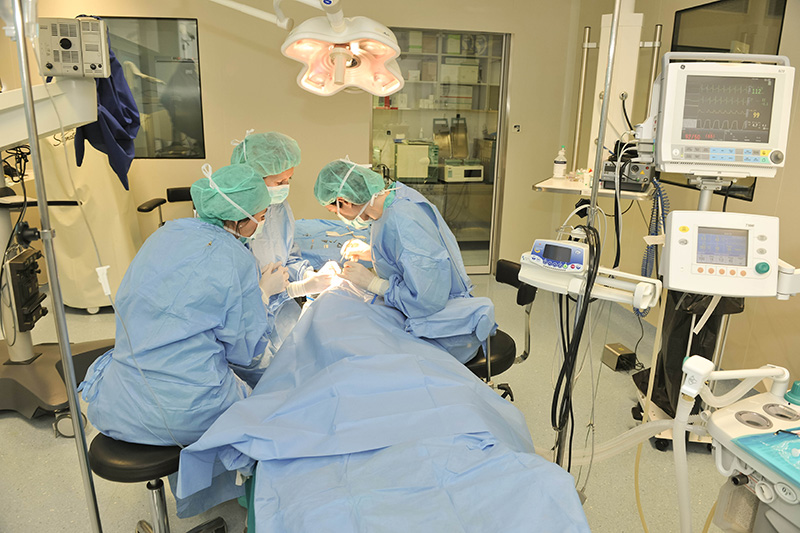What is strabismus?
Strabismus is a disorder of the position or movement of eyes in which both eyes do not have a common viewing direction. In healthy eyes, both eyes are directed at the same point, and the movements are coordinated. In some cases, strabismus occurs because the mobility of an eye in a particular direction is limited. In children, strabismus is usually congenital or developed in early childhood, but it can also be consequence of mechanical injuries (during birth) or various neurological and internal diseases. In adults, strabismus often develops after head or eye injury due to paralysis of some muscle that moves the eye. It can also develop during some endocrine and immune diseases (thyroid disease). The most common types of strabismus are esotropia (eyeturned inwards) and exotropia (outwards), vertical deviations are also possible (eye turned up or downwards). Strabismus is also often connected with other vision disorders (amblyopia, refractive errors, and nystagmus).

When surgey is needed?
Strabismus in children interferes with the healthy development of vision and therefore is highly important to start the treatment as soon as possible. It is often combined with other vision problems in children, and has to be treated in combination with other necessary procedures. One of the most seriusconsequences of strabismus is development of amblyopia in the squinting eye . . Strabismus can influence the development of the stereovision in children as well. In adult patients surgery is requiredfor double vision, when causingasthenopia (eyestrain) and headaches or sometimes for aesthetic reasons.
The eye is run by six muscles, impulse for the movementsarederived from the brain, and in normal conditions the impulsshoud be same for both eyes. Coordinated eye movements ensure the perfect co-operation of both eyes, which enables the development of binocular vision, i.e. collaboration while viewing with both eyes at the same time. If everything is perfectly aligned, two slightly different images (from two eyes) merge in the brain where a single image is created in three dimensions (stereo, 3D vision). If both eyes are not straight or the mobility of eyes are limited or not well coordinated patieentwill have double vision.
In such cases the brain cannot merge two different images together. In such situation adults will have double vision so they often have to cover one eye in every day’s activities. . Children's brain, which is much more flexible, will automatically exclude the eye that is not straight, so there is a danger that the previously mentioned amblyopia will occur in the excluded eye. As a result, binocularity and stereo vision will not develop.
Strabismus surgeries are performed in adults even when they do not have any disturbances (double vision), even though the vision development is already completed. In such cases, surgeries are being performed because of aesthetic and socioeconomic reasons (social stigma and exclusion). By removing strabismus, a better aesthetic appearance and easier social adjustment is offered to the patient.

How does the surgery look like?
In cases when the surgery is the best solution, after accurate preoperative examination, surgery on the muscles that move the eye is performed. Strabismus surgery is performed under general anesthesia and lasts, depending on the complexity of the procedure, from half an hour to an hour and a half. The aim of the surgery is to set the eyes in the desired position, and in the case of muscle palysis, better position and mobility is achieved. In order to achieve desired position of the eye, muscles are weakend or strengthen by moving their insertions, shortening, splitting of the muscles or creating a double insertion. In the case of muscle paralysis (reduced mobility), to the paralyzed muscles are joined together with healthy surrounding muscles in order to improve reduced mobility. Strabismus surgery helps the patient to keep both eyes straight and working together. In most cases, complete cure is achieved.
How does the recovery look like and how long does it last?
After strabismus surgery, the patient usually stays in th hospital during the night. The first control examination is performed the next morning. Children stay in the clinical accommodation together with a parent. In early postoperative period (up to seven days), feeling of discomfort and sensitivity to light is common. It takes several weeks of postoperative healing that eye becomes completely white.
In the period of up to three weeks after surgery, t eye drops are prescribed. During this period it is recommended to avoid serious physical efforts (gyms, exercising), pools and crowded rooms. Another control is carried out after a week, and third control is scheduled a month after the surgery.
Children can usually go again to kindergarten or school after two weeks. Return to the work depends on the type of job. In office jobs, it is possible to come back to work already after seven days.
Why clinic Svjetlost?
We are the only one in the region to carry out surgeries for all types of strabismus (horizontal, vertical, palsy, nystagmus, double vision) without waiting lists. We also perform strabismus surgeries on adults and the surgery of opening and irrigating the tear duct in children under a short-term general anesthesia. We use the same methods and surgical techniques used in the world's best centers. The clinic Svjetlost has performed the largest number of strabismus surgeries compared to all other private ophthalmologic institutions.
The clinic Svjetlost has been cooperating for a long time with the Department for Children and Strabismus of the Ludwig Maximilian University Clinic in Munich and with prof. Oliver Ehrt.


